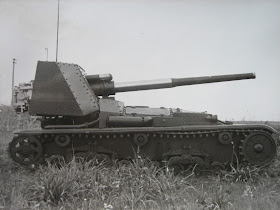Semovente M41M da 90/53
Se trata del cazacarros con mayor calibre montado por los italianos siendo fabricado por Fiat Ansaldo en junio de 1942 para intentar dotar a sus unidades de mayor capacidad anticarro, aunque solo se fabricaron 48 unidades. El cañón elegido, de 90 mm (Ansaldo Cannone da 90/53), era de origen naval y tenía un comportamiento similar al Flak 18 de 88 mm alemán en cuestión de penetración. Además de ello compartía también un doble propósito, antiaéreo y tiro rasante. El cañón tenía un alcance efectivo de 12.000 metros en tiro rasante pudiendo penetrar hasta 206 mm de blindaje.
La propuesta para el nuevo cazacarros surgió en la primavera de 1942 con el objetivo anteriormente mencionado. El bastidor elegido fue el de un carro M14/41 con una cámara de combate situada en la parte posterior y abierta por tres de sus lados que permitía el retroceso del arma principal. Esta podía girar 40º a cada lado con una depresión máxima de -5º y una elevación de +24º. El motor fue movido al centro del vehículo quedando el puesto de conductor intacto.
El conjunto tenía un peso total de 17 toneladas con un blindaje que oscilaba entre los 30 y los 6 mm. En su contra jugaba los 2,3 metros de altura, algo excesivo para un vehículo de estas características. Estaba impulsado por un motor FIAT SPA 15T de 125 caballos que le proporcionaba una velocidad máxima de 25 Km/h y una autonomía de 150 Km. El conjunto estaba tripulado por 4 hombres, dos de ellos situados tras el escudo del arma y los otros dos en tierra. Dado el gran tamaño de los proyectiles el vehículo no transportaba ninguno siendo transportados 26 de ellos por un vehículo ligero L-6 y otros 40 más por medio de un remolque.
Inicialmente se equiparon a tres unidades con el Semovente da 90/53 que se estaban manteniendo en reserva en la zona septentrional del país ya que el Alto Mando dudaba si enviarlos a Rusia o al norte de África. Tras el desembarco aliado en Sicilia fueron desplegados allí el 10 de julio de 1943 para hacer frente a la nueva amenaza. Tras el armisticio las unidades supervivientes quedaron bajo control alemán que lo emplearon como plataforma cazacarros de largo alcance.
Fuentes:
PIGNATO, N. “Italian Armored Vehicles of World War Two” Squadron/Signal, 2004
BISHOP, C. “The Encyclopedia of Weapons of World War II” Thunder Bay Press, 2006
English version
This is the tank destroyers with heavier gauge mounted by the Italians being manufactured by Fiat Ansaldo in June 1942 to try to provide its anti-tank units of larger capacity, but only 48 units were produced. The chosen gun, 90 mm (Ansaldo Cannone da 90/53), was of naval and had a behavior similar to 88 mm Flak 18 German issue of penetration. Moreover also shared a dual purpose antiaircraft and low shot. The gun had an effective range of 12,000 meters and can penetrate low shot up to 206 mm of armor.
The proposal for the new tank destroyer came in the spring of 1942 with the objective mentioned above. The frame chosen was that of a car with a camera M14/41 combat located in the back and open on three sides allowing the recoil of the weapon. This could turn 40 degrees to each side with a maximum depression of -5° and +24° elevation. The engine was moved to the center of the vehicle leaving the driving position intact.
A Semovente M.41M da 90/53 is examined by American troops after being knocked out in Sicily in 1943. To serve the gun, the crew had to stand behind the breech and only the driver had all-round armour. These guns were first used in North Africa in late 1943 and were much respected.
The set had a total weight of 17 tons with armor ranging from 30 to 6 mm. Played against the 2.3 meters high, probably overkill for a vehicle like this. It was powered by a FIAT SPA 15T 125 hp which provided a maximum speed of 25 km / h and a range of 150 km The whole was manned by 4 men, two of which are located behind the shield of the gun and the other two in earth. Given the large size of the projectiles did not carry any vehicle being transported 26 of them for a light vehicle L-6, and 40 more by a trailer.
Initially three units were equipped with Semovente da 90/53 that were holding in reserve in the north of the country and that the High Command was hesitant to send to Russia or North Africa. After the Allied landing in Sicily were deployed there on July 10, 1943 to address the new threat. After the armistice the surviving units came under German control was employed as long-range tank destroyer platform.
Initially three units were equipped with Semovente da 90/53 that were holding in reserve in the north of the country and that the High Command was hesitant to send to Russia or North Africa. After the Allied landing in Sicily were deployed there on July 10, 1943 to address the new threat. After the armistice the surviving units came under German control was employed as long-range tank destroyer platform.
Sources:
PIGNATO, N. “Italian Armored Vehicles of World War Two” Squadron/Signal, 2004
BISHOP, C. “The Encyclopedia of Weapons of World War II” Thunder Bay Press, 2006







No hay comentarios:
Publicar un comentario